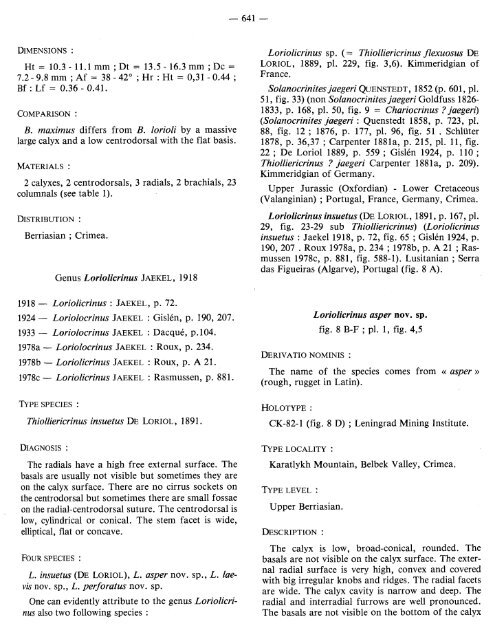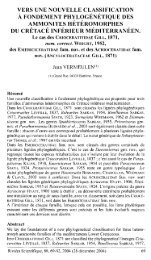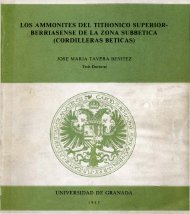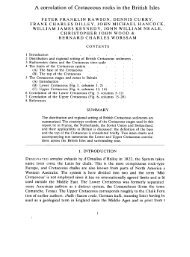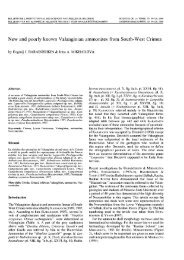thiolliericrinid crinoids from the lower cretaceous of crimea
thiolliericrinid crinoids from the lower cretaceous of crimea
thiolliericrinid crinoids from the lower cretaceous of crimea
Create successful ePaper yourself
Turn your PDF publications into a flip-book with our unique Google optimized e-Paper software.
— 641 —Dimensions :Ht = 10.3 - 11.1 mm ; Dt = 13.5 - 16.3 mm ; De =7.2 - 9.8 mm ; A f = 38 - 42° ; Hr : H t = 0,31 - 0.44 ;Bf : Lf = 0.36 - 0.41.Comparison :В. maximus differs <strong>from</strong> В. lorioli by a massivelarge calyx and a low centrodorsal with <strong>the</strong> flat basis.Materials :2 calyxes, 2 centr odor sals, 3 radiais, 2 brachials, 23columnals (see table 1).Distribution :Berriasian ; Crimea.Genus Loriolicrinus Jaek el, 1918Loriolicrinus sp. (= Thiolliericrinus flexuosus DeL o r i o l , 1889, pi. 229, fig. 3,6). Kimmeridgian <strong>of</strong>France.Solanocrinites jaegeri Q u e n s t e d t , 1852 (p. 601, pi.51, fig. 33) (non Solanocrinites jaegeri Goldfuss 1826-1833, p. 168, pi. 50, fig. 9 = Chariocrinus ? jaegeri)(Solanocrinites jaegeri : Quenstedt 1858, p. 723, pi.88, fig. 12 ; 1876, p. 177, pi. 96, fig. 51 . Schliiter1878, p. 36,37 ; Carpenter 1881a, p. 215, pi. 11, fig.22 ; De Loriol 1889, p. 559 ; Gislén 1924, p. 110 ;Thiolliericrinus ? jaegeri Carpenter 1881a, p. 209).Kimmeridgian <strong>of</strong> Germany.Upper Jurassic (Oxfordian) - Lower Cretaceous(Valanginian) ; Portugal, France, Germany, Crimea.Loriolicrinus insuetus (De L o r i o l , 1891, p. 167, pi.29, fig. 23-29 sub Thiolliericrinus) (Loriolicrinusinsuetus : Jaekel 1918, p. 72, fig. 65 ; Gislén 1924, p.190, 207 . Roux 1978a, p. 234 ; 1978b, p. A 21 ; Rasmussen1978c, p. 881, fig. 588-1). Lusitanian ; Serradas Figueiras (Algarve), Portugal (fig. 8 A).1918 — Loriolicrinus : Ja ek el, p. 72.1924 — Loriolocrinus Jaekel : Gislén, p. 190, 207.1933 — Loriolocrinus Jaekel : Dacqué, p. 104.1978a — Loriolocrinus Jaekel : Roux, p. 234.1978b — Loriolicrinus JAEKEL : Roux, p. A 21.1978c — Loriolicrinus Ja e k e l : Rasmussen, p. 881.Type species :Thiolliericrinus insuetus De Lo rio l, 1891.D e r iv a t io n o m i n i s :Loriolicrinus asper nov. sp.fig. 8 B-F ; pl. 1, fig. 4,5The name <strong>of</strong> <strong>the</strong> species comes <strong>from</strong> « asper »(rough, rugget in Latin).H o l o t y p e :CK-82-1 (fig. 8 D) ; Leningrad Mining Institute.Diagnosis :The radiais have a high free external surface. Thebasais are usually not visible but sometimes <strong>the</strong>y areon <strong>the</strong> calyx surface. There are no cirrus sockets on<strong>the</strong> centrodorsal but sometimes <strong>the</strong>re are small fossaeon <strong>the</strong> radial-centrodorsal suture. The centrodorsal islow, cylindrical or conical. The stem facet is wide,elliptical, flat or concave.Four species :L. insuetus (De Loriol), L. asper nov. sp., L. laevisnov. sp., L. perforatus nov. sp.One can evidently attribute to <strong>the</strong> genus Loriolicrinusalso two following species :T y p e l o c a l it y :Karatlykh M ountain, Belbek Valley, Crimea.T y p e l e v e l :Upper Berriasian.D e s c r i p t i o n :The calyx is low, broad-conical, rounded. Thebasais are not visible on <strong>the</strong> calyx surface. The externalradial surface is very high, convex and coveredwith big irregular knobs and ridges. The radial facetsare wide. The calyx cavity is narrow and deep. Theradial and interradial furrows are well pronounced.The basais are not visible on <strong>the</strong> bottom <strong>of</strong> <strong>the</strong> calyx


